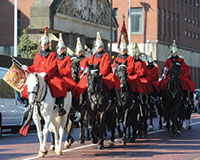 The sales process for one of the most high-profile prime residential development opportunities in central London has been kick-started.
The sales process for one of the most high-profile prime residential development opportunities in central London has been kick-started.
Bilfinger GVA has been appointed by the Ministry of Defence to undertake scenario testing and relocation options for Hyde Park Barracks, SW7, with the intention of asking for bids towards the end of 2017.
The six-acre site next to Hyde Park has the potential for a development with an end value of well in excess of £1bn, but a deal has thus far proved complex to unlock.
Plans for redevelopment have to take into account the rehousing and potential relocation of the Household Cavalry Mounted Regiment, which has more than 200 horses and ancillary support functions.
Market testing in 2012 had required any relocation be within 4km of Horse Guards Parade, SW1, and within 1km of an outdoor equestrian area and park land, but it is understood that these constraints may be modified.
Barney Hillsdon, senior director at Bilfinger GVA, said: “Bilfinger GVA has been appointed by the MoD to act on its behalf in an agency, procurement and planning capacity.
“The mandate will actively consider a number of opportunities presented by its central London estate to deliver defence outputs from an optimised footprint.
“Our preparatory work will determine the detail of the Ministry of Defence’s requirement, aligned with its wider Footprint Strategy, with the aim of coming to market around the end of 2017.”
Bilfinger GVA will advise the MoD on the best option for the site. Questions that need to be considered include:
- Will horses have to remain at Hyde Park Barracks?
- If the horses must stay, how many?
- Where will ancillary offices for the regiment be based?
Solutions range from a complete relocation to a shared site.
An off-site solution would involve a new site being proposed and then built by the development partner to provide new facilities for the horses. Once this has been completed, and the cavalry decamped, construction can begin on the barracks site itself.
As an alternative, the Horse Guards could decide they must stay in Hyde Park and propose a scheme that involves them being shunted to one end of the strip of land in new lodgings, and the other end developed into residential.
Bilfinger GVA will also co-ordinate masterplanning for any new development and is likely to undertake the ultimate sales process.
Hyde Park Barracks: a short history
- The site has been the base for the Household Cavalry Mounted Regiment, which also mounts the Queen’s Life Guard at Horse Guards, since the first buildings were constructed for the Horse Guards in 1795.
- The Sir Basil Spence-designed modernist scheme completed in 1970.
- In June 2012, CBRE was appointed for initial advice on what the Defence Infrastructure Organisation calls a “market-testing exercise” to decide the future of the site.
- In January 2014, speculation abounded about the site being sold.
- Paul Howarth, the civil servant in charge of the project, left the DIO in January 2014, slowing the sales process.
- MoD drafted plans in May 2015 for a potential sale of site through the DIO, though there was no official announcement.
- Lipton Rogers Developments, SD&B International and CPC Group, and the Qatar Investment Authority have all previously looked at the site.
- The estimated value of the site is £500m-£650m, with some schemes rumoured to have potential end values of £2bn.
A muddled melee: the challenges of Hyde Park Barracks
A relocation would require the new barracks to be designed and built by the developer, which could take three to four years, and cost hundreds millions of pounds. Designing and redeveloping the old site could take a further three to four years. Any potential developer could be stuck with a considerable bill and eight years of delay before realising any profit.
- Ownership: the land is owned by Royal Parks, and the site by the MoD. A conversion back to civilian use needs an act of parliament.
- Listing: Architectural society C20 applied to have the 94m tower listed in 2015. The bid was rejected by culture minister Tracey Crouch.
- Military requirements: Requirements for a relocation needed to be within 4km of Horse Guards Parade, within 1km of an outdoor equestrian area and park, and have space for an indoor equestrian area.
- Planning and prime vales: Planning could be difficult to obtain, at least for a tower of similar height, while Westminster Council’s Article 4 would prohibit an office-to-resi conversion. Meanwhile, the prime residential market has cooled considerably.
• To send feedback, e-mail alex.peace@estatesgazette.com or tweet @egalexpeace or @estatesgazette










